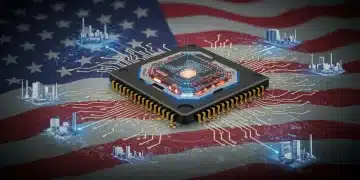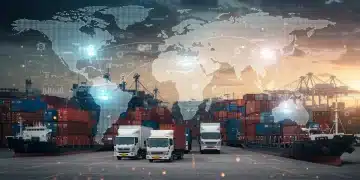AI & IoT: Transforming US Export Strategies (2024-2027)
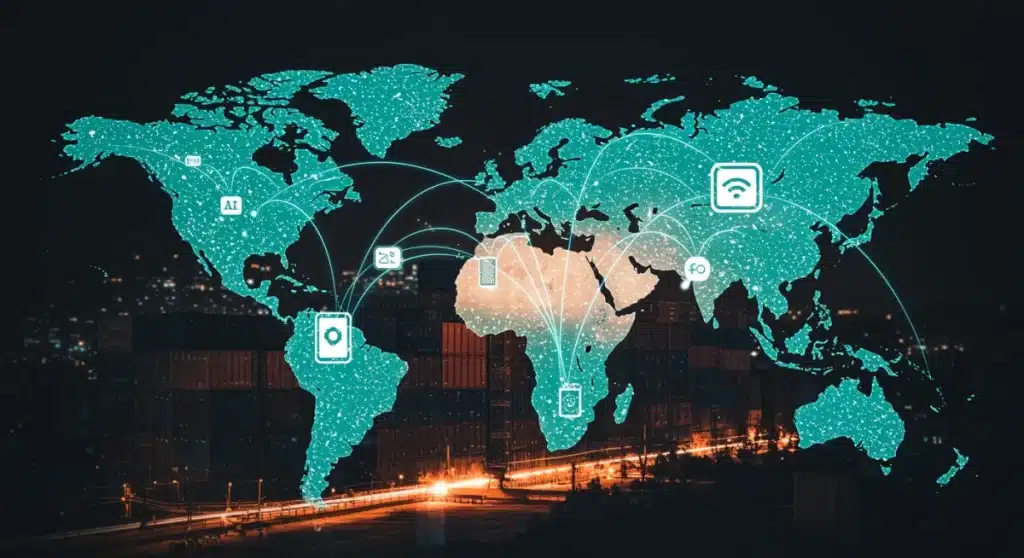
The future of global trade is rapidly evolving, with AI and IoT interconnectivity set to fundamentally transform U.S. export strategies over the next three years, driving unprecedented efficiency, market responsiveness, and competitive advantage in a complex global landscape.
AI IoT US Exports are at the forefront of a profound shift in global commerce, demanding immediate attention from businesses and policymakers alike. Over the next three years, the integration of Artificial Intelligence and the Internet of Things will not merely optimize existing processes but redefine the very foundations of how U.S. goods and services reach international markets. This transformation promises to unlock new levels of efficiency, reshape supply chains, and create dynamic opportunities for American enterprises on the global stage.
The AI and IoT Revolution in Supply Chains
The convergence of AI and IoT is creating intelligent, self-optimizing supply chains, a critical development for U.S. export strategies. Real-time data from IoT devices, spanning from factory floors to shipping containers, feeds into AI algorithms that predict demand, optimize logistics, and identify potential disruptions before they escalate. This proactive approach significantly reduces operational costs and enhances delivery reliability for U.S. exporters.
For instance, smart sensors embedded in cargo containers can monitor temperature, humidity, and location, providing continuous updates that AI systems analyze to ensure product integrity and efficient routing. This level of granular visibility was once unimaginable but is now becoming standard, allowing U.S. companies to offer unparalleled transparency and reliability to international buyers.
Real-time Visibility and Predictive Analytics
- Enhanced Tracking: IoT sensors provide live data on goods in transit, from manufacturing to last-mile delivery, crucial for high-value or time-sensitive exports.
- Demand Forecasting: AI analyzes vast datasets, including historical sales, geopolitical events, and social media trends, to predict international demand with greater accuracy.
- Route Optimization: Machine learning algorithms continuously refine shipping routes, considering weather patterns, port congestion, and geopolitical risks, reducing transit times and costs.
The ability to leverage real-time data and predictive analytics allows U.S. exporters to respond with unprecedented agility to market changes, a distinct competitive advantage. This also fosters greater trust with international partners, knowing that their shipments are managed with the highest degree of precision and foresight.
Optimizing Production and Inventory for Global Markets
AI and IoT are not just transforming the movement of goods but also their creation and storage. Smart factories, equipped with IoT sensors on machinery, can monitor production lines, predict maintenance needs, and optimize output to meet specific export orders. This level of automation and data-driven decision-making ensures that U.S. manufacturers can produce goods efficiently and adapt quickly to fluctuating international demand.
Inventory management, a perennial challenge in global trade, is also being revolutionized. AI-powered systems can manage warehouse operations, from automated picking and packing to dynamic storage solutions, minimizing waste and ensuring goods are ready for export exactly when needed. This seamless integration of production and inventory processes directly supports more responsive and cost-effective export operations.
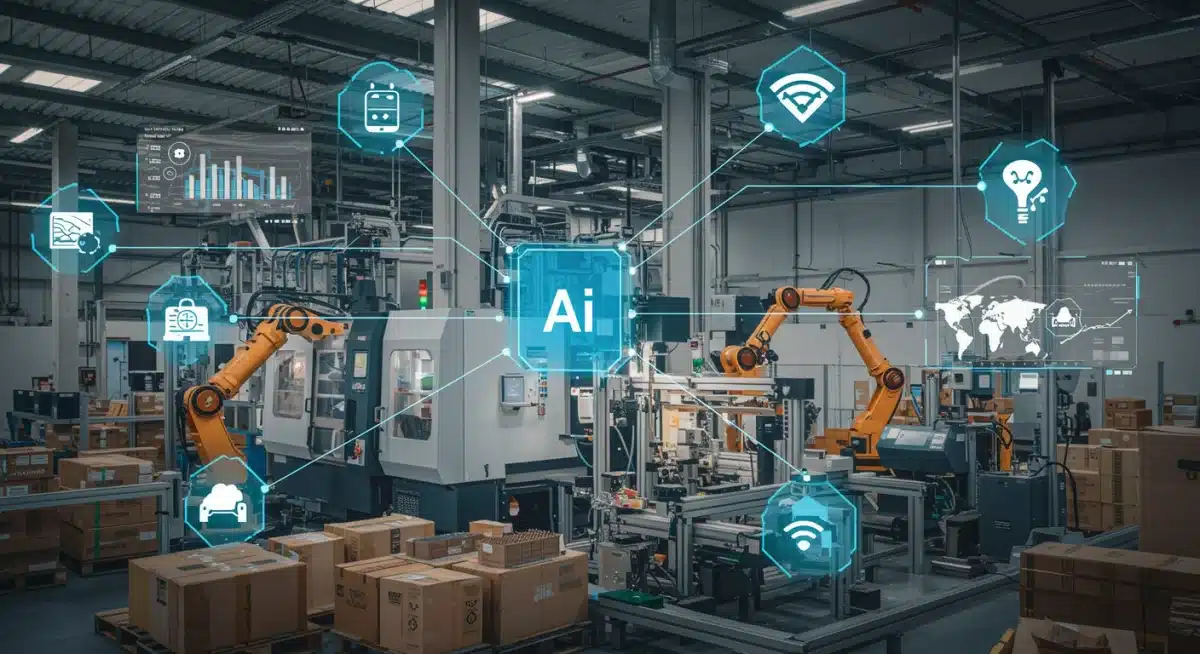
Smart Manufacturing for Export Readiness
The adoption of smart manufacturing practices, driven by AI and IoT, directly impacts the competitiveness of U.S. exports. Factories can achieve higher levels of customization and quality control, addressing the diverse requirements of different international markets. This technological edge allows U.S. products to stand out in a crowded global marketplace, reinforcing their reputation for innovation and reliability.
Moreover, the data generated from these smart environments provides invaluable insights into production bottlenecks and efficiencies, allowing for continuous improvement that further strengthens the U.S. export position. This continuous feedback loop ensures that American manufacturing remains at the cutting edge of global supply and demand.
Enhancing Trade Compliance and Risk Management
Navigating the complex landscape of international trade regulations is a significant hurdle for U.S. exporters. AI and IoT are emerging as powerful tools to streamline compliance and mitigate risks, offering automated solutions for documentation, customs procedures, and adherence to varying international standards. This reduces the burden on businesses and minimizes the potential for costly delays or penalties.
AI algorithms can rapidly process vast amounts of regulatory data, flagging potential compliance issues before they arise and suggesting corrective actions. Meanwhile, IoT devices can provide verifiable data on product origin, composition, and handling, crucial for meeting stringent import requirements in different countries. This robust framework for compliance is vital for maintaining the integrity and reputation of U.S. exports.
Automated Compliance and Fraud Detection
- Regulatory Monitoring: AI continuously tracks changes in international trade laws and tariffs, alerting exporters to relevant updates.
- Document Automation: AI-powered platforms can generate and verify necessary export documentation, reducing manual errors and processing times.
- Counterfeit Prevention: IoT-enabled product serialization and blockchain integration help authenticate goods, combating counterfeiting and ensuring brand protection in foreign markets.
By automating and enhancing compliance processes, U.S. businesses can confidently expand into new markets, knowing they have robust systems in place to manage regulatory complexities. This proactive risk management approach is essential for scaling export operations effectively and securely.
New Market Entry and Customer Engagement
AI’s analytical capabilities extend beyond logistics and production to identifying untapped international markets and tailoring export strategies to specific consumer behaviors. By analyzing global economic data, demographic shifts, and online trends, AI can pinpoint regions with high demand for U.S. products or services, providing actionable intelligence for market entry.
Furthermore, AI-driven platforms can personalize customer engagement for international buyers, from multilingual support chatbots to customized product recommendations. This enhances the buying experience, builds customer loyalty, and ultimately drives increased export sales for U.S. companies. The ability to connect with global customers on a personalized level is a distinct advantage.
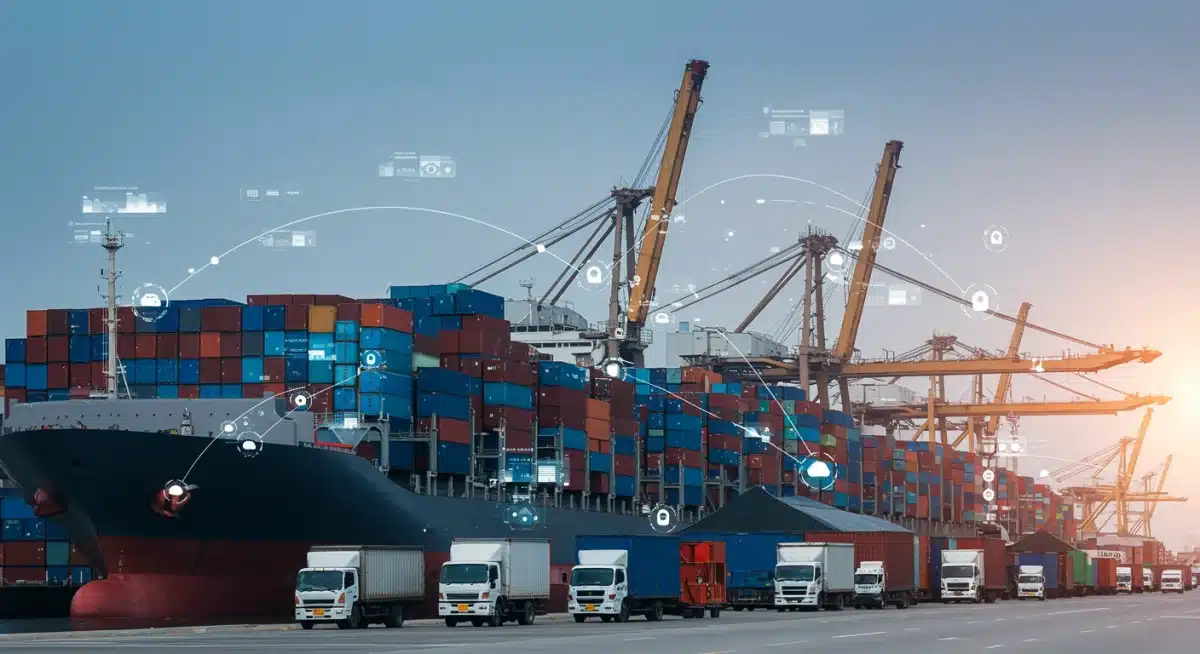
Data-Driven Market Expansion
The strategic application of AI in market research allows U.S. exporters to move beyond traditional, often slow, market analysis. Instead, they can leverage real-time data to identify niche markets, understand cultural nuances, and develop highly targeted marketing campaigns. This precision in market entry significantly reduces the risks associated with international expansion and maximizes return on investment.
For example, AI can analyze social media conversations in different languages to gauge sentiment towards certain products or identify emerging consumer needs, providing U.S. businesses with an invaluable competitive edge in their export endeavors. This dynamic understanding of global consumer behavior is crucial for sustained export growth.
Challenges and Ethical Considerations
While the benefits of AI and IoT in U.S. export strategies are substantial, their implementation also presents significant challenges and ethical considerations. Data security and privacy are paramount, especially when dealing with international data flows and varying regulatory frameworks like GDPR. Ensuring the integrity and confidentiality of sensitive trade data is a critical ongoing task.
Furthermore, the ethical implications of AI’s decision-making processes, such as potential biases in algorithms that could impact trade relationships or market access, must be carefully addressed. U.S. exporters must prioritize transparent and responsible AI deployment to maintain trust and avoid unintended consequences in global commerce.
Navigating the Digital Landscape
- Data Governance: Establishing robust frameworks for data collection, storage, and sharing across international borders is essential.
- Cybersecurity Threats: Protecting IoT devices and AI systems from cyberattacks is crucial to prevent disruptions and data breaches in the export supply chain.
- Algorithmic Bias: Developers must actively work to identify and mitigate biases in AI algorithms to ensure fair and equitable trade practices.
Addressing these challenges requires a concerted effort from businesses, technology providers, and government entities to develop best practices, establish international standards, and foster a secure and ethical digital trade environment. The long-term success of AI and IoT in U.S. exports hinges on proactively confronting these complex issues.
Government Initiatives and Policy Frameworks
Recognizing the transformative potential, the U.S. government is actively exploring and implementing policies to support the integration of AI and IoT into national export strategies. This includes funding for research and development, creating regulatory sandboxes for new technologies, and fostering international cooperation on digital trade standards. These initiatives aim to create a conducive environment for American businesses to leverage these technologies.
For example, agencies like the Department of Commerce are working to provide resources and guidance for small and medium-sized enterprises (SMEs) to adopt AI and IoT solutions, ensuring that the benefits of this technological revolution are broadly accessible across the U.S. export landscape. Such support is critical for maintaining a competitive edge in global markets.
Supporting the Digital Export Ecosystem
Government policies are focusing on several key areas to bolster the role of AI and IoT in exports. These include promoting digital literacy, investing in critical infrastructure, and advocating for open and fair digital trade policies internationally. The goal is to build a resilient and technologically advanced export ecosystem that can adapt to future global challenges and opportunities.
Ongoing dialogues with industry leaders and academic experts are informing these policy developments, ensuring that government initiatives are responsive to the real-world needs of U.S. exporters. This collaborative approach is vital for the effective integration of AI and IoT into the national trade agenda.
Key Aspect |
Impact on US Exports |
|---|---|
Supply Chain Optimization | AI and IoT enable real-time tracking, predictive analytics, and efficient routing, reducing costs and improving reliability. |
Production Efficiency | Smart factories and AI-driven inventory management optimize manufacturing and readiness for global demand. |
Trade Compliance & Risk | Automated regulatory monitoring and fraud detection streamline customs and reduce compliance risks. |
Market Expansion | AI identifies new market opportunities and allows for personalized customer engagement, boosting sales. |
Frequently Asked Questions About AI and IoT in US Exports
AI and IoT will revolutionize U.S. export logistics by providing real-time tracking, predictive maintenance for vehicles, and optimized route planning. This leads to reduced transit times, lower operational costs, and significantly improved reliability for international shipments, making U.S. goods more competitive globally.
AI analyzes vast datasets, including global economic indicators, consumer behavior trends, and geopolitical stability, to pinpoint emerging markets with high demand for U.S. products. This data-driven approach allows businesses to make informed decisions for market entry and tailor their export strategies effectively.
Smart factories use IoT sensors to monitor production lines, optimize output, and predict maintenance needs, leading to increased efficiency and higher quality control. This enables U.S. manufacturers to meet diverse international demand with greater agility and cost-effectiveness, strengthening their global competitiveness.
Key challenges include ensuring data security and privacy across international borders, managing cybersecurity risks for interconnected systems, and addressing potential biases in AI algorithms. Overcoming these requires robust data governance, strong cybersecurity measures, and ethical AI development practices.
The U.S. government supports this integration through funding R&D, creating regulatory sandboxes, fostering international cooperation on digital trade standards, and providing resources for SMEs. These initiatives aim to build a robust and technologically advanced export ecosystem.
Looking Ahead
The trajectory for AI IoT US Exports over the next three years indicates a period of dynamic transformation. Businesses must prioritize investment in these technologies, while policymakers continue to refine frameworks that support innovation, ensure data security, and promote ethical deployment. The success of U.S. export strategies will increasingly hinge on the agile and responsible integration of AI and IoT, shaping a more efficient, resilient, and competitive presence in the global marketplace.




